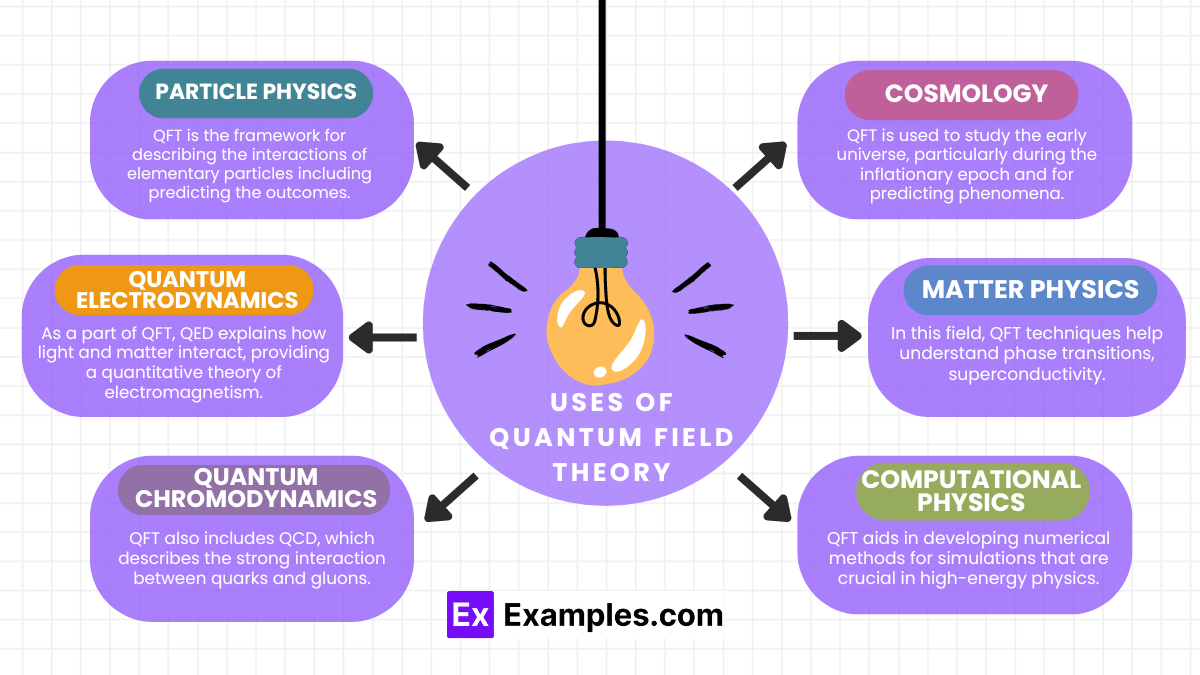What does Quantum Field Theory (QFT) primarily describe?
The behavior of particles in a gravitational field
The quantum behavior of fields and their interactions
The motion of celestial bodies
The thermal properties of solids


Quantum Field Theory (QFT) merges quantum mechanics with the laws of physics governing fields, portraying particles such as electrons and photons as excitations of these fields. It fundamentally transforms our understanding of matter and energy by describing interactions and transformations of particles under the framework of field dynamics. This theory is pivotal in modern physics, providing the mathematical structure to study and predict particle behavior at the quantum level, and is integral to the Standard Model of particle physics.
Quantum Field Theory (QFT) involves complex mathematics and multiple formulas depending on the specific interaction or particle being studied. However, a foundational formula in QFT is the Lagrangian, which is used to describe the dynamics of fields and their interactions. A general form of the QFT Lagrangian for a scalar field ϕ can be written as:
Here:
This formula encapsulates how the field behaves, how it interacts with itself, and its dynamics within spacetime, providing a base from which more specific and detailed interactions can be derived in QFT.
Deriving the foundational equations of Quantum Field Theory (QFT) is a comprehensive process that involves several steps, integrating concepts from both quantum mechanics and classical field theory. Here’s a simplified outline of the derivation process for a basic scalar field theory:
Step 1: Start with Classical Field Theory
Step 2: Quantize the Field
Step 3: Introduce Interactions
Step 4: Solve Using Perturbation Theory

Quantum Field Theory (QFT) is a powerful tool in modern physics, underpinning many significant discoveries and technologies. Here are some practical examples illustrating its applications:
Quantum field theory is extensively supported by experimental evidence, particularly through precise predictions matching experimental results in particle physics.
Quantum field theory combines advanced mathematics with complex physical concepts, challenging even experienced physicists due to its abstract nature and technical rigor.
Key contributors include Paul Dirac, Richard Feynman, and Julian Schwinger, each providing foundational insights and methodologies that shaped the development of quantum field theory.
Text prompt
Add Tone
10 Examples of Public speaking
20 Examples of Gas lighting
What does Quantum Field Theory (QFT) primarily describe?
The behavior of particles in a gravitational field
The quantum behavior of fields and their interactions
The motion of celestial bodies
The thermal properties of solids
What is the fundamental entity in QFT?
Particle
Field
Wave
String
What mathematical structure is used to describe the fields in QFT?
Differential equations
Matrix mechanics
Operator algebra
Tensor calculus
What does the term "quantization" refer to in QFT?
The process of measuring physical quantities
The conversion of classical fields into quantum operators
The increase of energy levels
The reduction of wavefunctions
Which theory combines QFT with special relativity?
General relativity
Quantum mechanics
Quantum electrodynamics (QED)
String theory
What is the role of Feynman diagrams in QFT?
To visualize the behavior of classical fields
To represent particle interactions pictorially
To solve differential equations
To measure physical constants
In QFT, what are virtual particles?
Particles with real mass
Particles that exist temporarily during interactions
Particles that travel faster than light
Particles with infinite energy
What is a key feature of the Standard Model of particle physics?
It describes gravitational interactions
It explains the behavior of dark matter
It unifies electromagnetic, weak, and strong forces
It predicts the existence of superparticles
What particle is associated with the Higgs field in the Standard Model?
Photon
Electron
Gluon
Higgs boson
What is the significance of gauge symmetry in QFT?
It describes the motion of particles
It ensures the conservation of energy
It provides a framework for field interactions
It explains the expansion of the universe
Before you leave, take our quick quiz to enhance your learning!

